Yes, Eastern Kingbirds are the large black and white flycatchers that have the straight white lines across the bottom of their tails. That line is so useful for identifying them! In my teens, I would often see these birds at the edge of a lake flying out to hunt from silver maple trees near the water’s edge. For that reason, I started thinking of them as water birds and had to adjust my ideas recently when I found they are quite common inland too. I noticed them during recent summers nesting at the edge of several fields in Bronte Creek Provincial Park, as well as along the Credit River and several small lakes.
Do Both Male and Female Kingbirds Incubate the Eggs?
In June, I noticed a Kingbird perched in a tree near the Credit River in Riverwood and stopped to try for a photo. After I had taken a few, its partner flew in and they interacted with calling and perching for a few seconds. Then, to my surprise, the new arrival settled on a nest: I had not noticed that the first bird had been perched on a branch quite close to the nest the whole time I was trying for a photo.
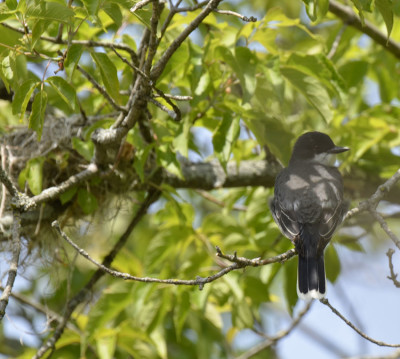
This bird was perched on a bare twig quite close to the nest on the left.
That made me curious: Had I been watching a male who was keeping an eye on his nest while his partner was out for a stretch or a meal? Or was it the female watching the nest while the male hunted? Do both incubate the eggs? Is it normal for the non-incubator to guard the eggs even if he or she won’t sit on them? (It was also a sunny warm day in June so it’s possible that the eggs did not need incubation to stay warm.)
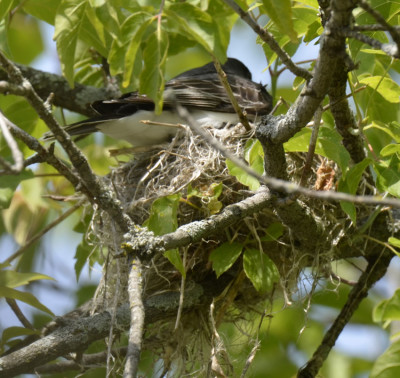
After exchanging greetings this bird stepped up onto the nest.
The AllAboutBirds site mentions that males will often perch near the nest site while the female is building the nest, but it doesn’t talk about incubation. The BioKids website hosted by the University of Michigan says that only the females incubate the eggs although both partners feed insects to the young. The Audubon website says that the incubation is either mostly or entirely provided by the female.
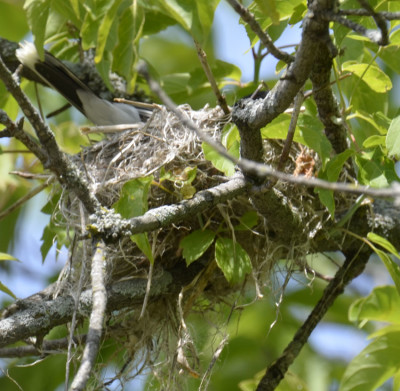
It then settled in on top of the eggs.
If so, it was probably the male I saw perched while the female was out and about. I can’t tell just by looking at the bird because the sexes are very similar in appearance.
Have I Ever Seen a Kingbird’s Red Crown?
I noticed the AllAboutBirds website does not list the red (sometimes orange or yellow) feathers that make the Kingbird’s crown under the species description. Instead, they are described on the Life History page because they are so rarely seen. When the Kingbirds are calm, these brightly coloured feathers on the very top of their heads are hidden.
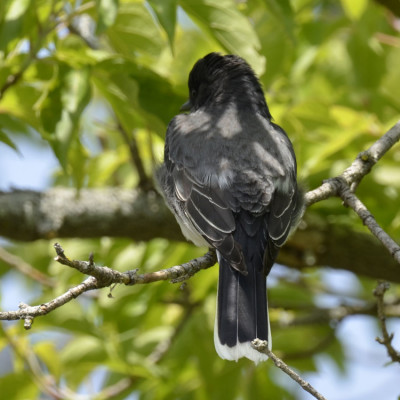
Fortunately, the white bar at the end of the Kingbird’s tail is highly visible and a good id clue.
I did see the red once, though, when I was a teen. The birds were flying out from a tree beside the lake, probably their nest tree, and one flashed its red spot a few times, possibly at me, but more likely at a rival or a predatorial blue jay, blackbird or crow nearby. I was very pleased at the time to see the field mark because I knew it was not commonly viewed. I’m even more pleased now, because I haven’t seen one since!

I can’t turn my head this far to the back.
I found this view of the Kingbird interesting: you can see that like an owl it can almost turn its head fully to the back. If you check, you’ll notice that this bird is perched facing away from the camera but has swiveled its head almost 180 to look directly back over its shoulder.
Related Reading
Join In
Do Kingbirds reign from a tree near you? Please share your sighting with a comment.

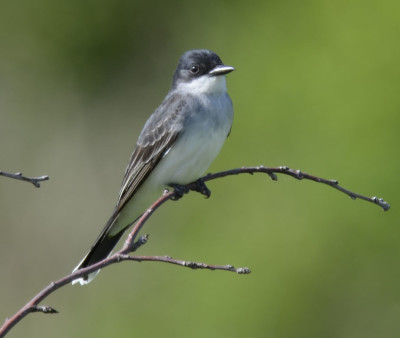
Just saw my first kingbirds! Mom and two fledglings just outside my window! One fledgling hung out for a few minutes- saw him catch a bug and eat it! So excited!
West Brandywine Township, Chester County, PA.
What a great thing to watch! Thanks for sharing.
I just saw my first pair, in Dipper Harbour, New Brunswick! Beautiful! One kept looking right up my binonculars for about 5 minutes, and then flew to join another and they flew off together. M <.
Sounds like a great view!
thanks for enabling me to i.d. the eastern kingbird i saw today at massabesic audubon in auburn, nh.
They are quite a striking flycatcher–thanks for sharing yours!
Sitting here in Rural Worcester MA. spotted many eastern kingbirds id’ed from this! TY
They are great insect eaters so you may be glad to have them nearby! Thanks for sharing.
I live in southwestern iowa. I just spotted these quick little hunters today. I’m thankful to have them visit as I have plenty of flying food for them to eat. A day like today after so many cloudy days of rain it’s a nice to have something like this to enjoy.
Was able to id an eastern kingbird this weekend in Osage Beach, MO. Thanks for helping me and my kids out!!
Saw one today in my backyard in Laurel Delaware! Such a beautiful bird, it was sitting for a long time atop a branch on my brush pile . Thank you for your help in identifying it ! Beth. W.
Sounds like that one liked being admired!
I was near the Holland River near Newmarket Ontario when I saw what seemed like a black bird but lighter- I then saw the tail just as you show and describe. I’ll ride over shortly and see if I can get a pic. I’ve never seen one before. Thanks for the great details and story you provide.
sounds like it probably was a Kingbird–I hope you see it again!